ECU BUICK ROADMASTER 1993 User Guide
[x] Cancel search | Manufacturer: BUICK, Model Year: 1993, Model line: ROADMASTER, Model: BUICK ROADMASTER 1993Pages: 340, PDF Size: 18.34 MB
Page 110 of 340
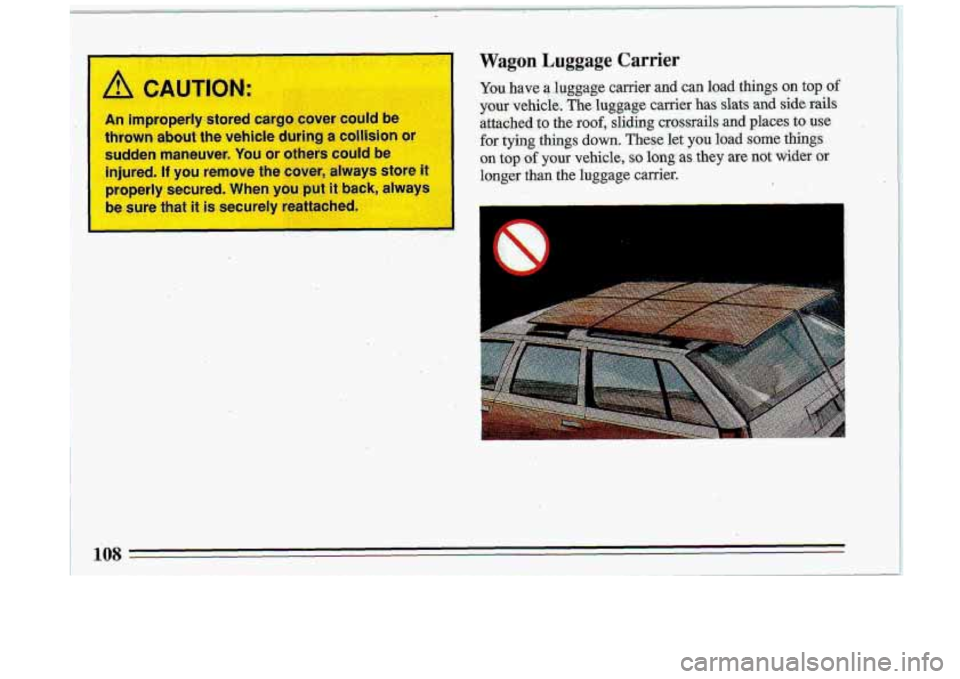
A CAUTION:
An improperly stored cargo cover could be
thrown about the vehicle during a collision (-
sudden maneuver. You or others could be
injured.
If you remove the cover, always store it
properly secured. When you put it back,
ah
be sure that it is secure attached.
- - ..
Wagon Luggage Carrier
You have a luggage carrier and can load things on top of
your vehicle. The luggage carrier has' slats ,and side rails
attached
to the roof, sliding crossrails and places to use.
for tying things down. These let you load some things
on
top of your vehicle, so long. as they -are not wider or
longer than the luggage carrier. I. I '.. ,;:; ' .,P
Page 111 of 340
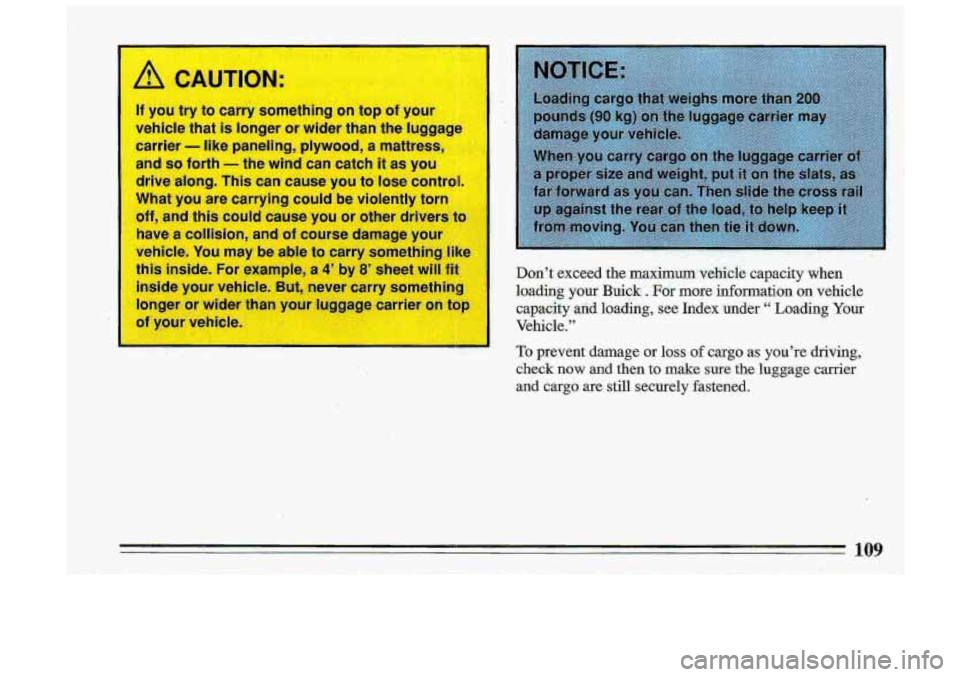
/! CA ,UTI01
If you try ta wry s net lg on top of your
vehicle
that is longer or wider than the luggage
carrier
- like paneling, plywood, a mattress,
and
so forth -the wind can catch it as you
drive along. This can cause you to
lose cont
What you are carrying could be violently torn
off, and this could cause you or other drivers
have
a collision, and of course damage your
vehicle. You may be able to carry something
this inside.
For example, a 4’ by-8’ sheet Will fiw’ aon’t.exceed,the maimm,v&i& capacity when
inside your vehicle. But, never carry something loading your. Buick . For ‘more information on vehicle
longer or wider than your luggage carrier ~ I top eqadty arid loading, see. Index -under ‘‘ Loading Yo-ur
of your vehicle. Vehicle.”
To prevent damage OT loss of cargo as you’re driving,
check-now
and then to make sure the luggage carrier
and cargo are still securely fastened.
109
Page 149 of 340
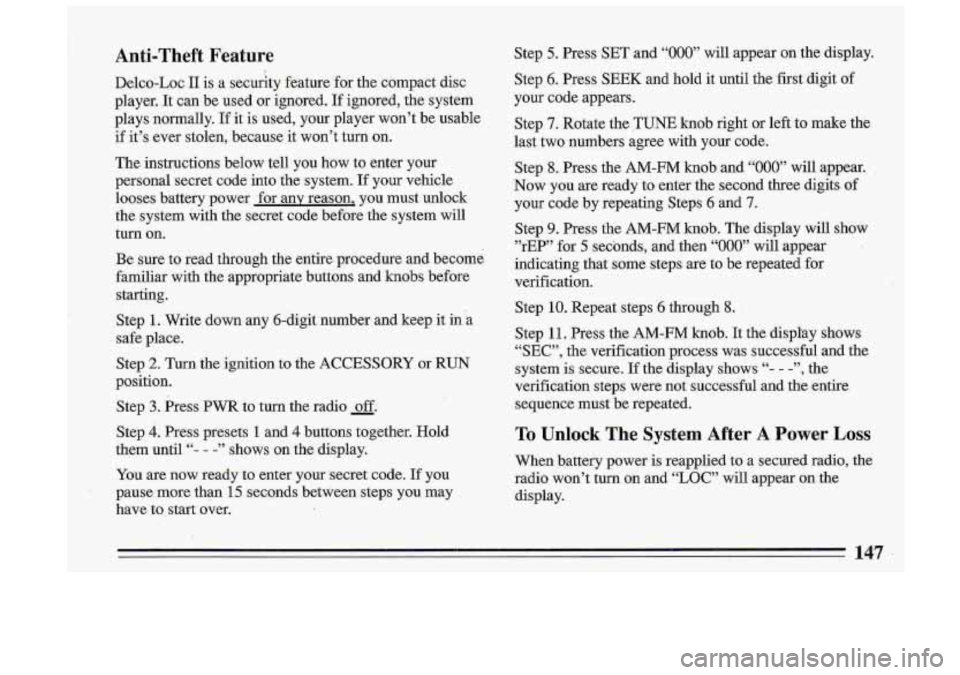
Anti-Theft Feature
Delco-Loc I1 is a security feature for the compact disc
player. It can be used or ignored. If ignored, the system
plays normally.
If it is used, your player won’t be usable
if it’s ever stolen, because it won’t turn on.
The instructions below tell you how
to enter your
personal secret code into the system.
If your vehicle
looses battery power for any reason,
you must unlock
the system with the secret code before the system will
turn on.
Be sure to read through the entire procedure and become
familiar with the appropriate buttons and
knobs before
starting.
Step
1. Write down any 6-digit number and keep it in a
safe place.
Step
2. Turn the ignitioin to the ACCESSORY or RUN
position.
Step
3. Press PWR to turn the radio off.
Step 4. Press presets 1 and 4 buttons together. Hold
them until
“- - -” shows on. the display.
You are
now ready to enter your secret code. If you
pause more than
15 seconds between steps you may
have to,start over.
1
Page 150 of 340
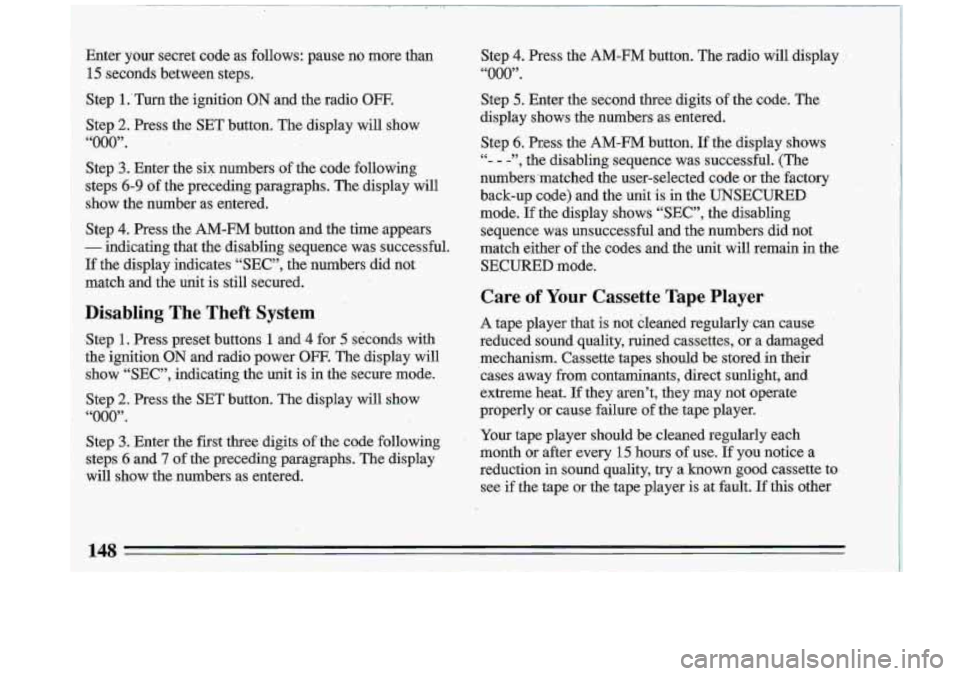
Step 4. Press the AM-FM button. The radio will display
“000”.
Step 5. Enter the second three digits of the code. The
display shows the numbers as entered.
Step
6. Press the AM-FM button. If the display shows
“- - -”, the disabling sequence was successful. (The
numbers .matched the user-selected code
or the factory
back-up code) and the
unit is in the UNSECURED.
mode. If the display shows “SEC”, the disabling sequence was unsuccessful and the numbers did not
match either of the codes and the unit will remain in the
SECURED mode.
C-are of Your Cassette Tape Player
A tape player that is not cleaned regularly can cause
reduced sound quality, ruined cassettes, or a damaged mechanism. Cassette -tapes should be stored in. their
cases away from contaminants, direct sunlight, and
extreme heat. If they aren’t, they may not operate
properly or cause failure
of the tape player.
I Your tape player should be cleaned regularly each
month or after every
15 hours of use. If you notice a
reduction in sound quality, try a known good cassette to
see
if the tape or the tape player is at fault. .E this other
Page 193 of 340
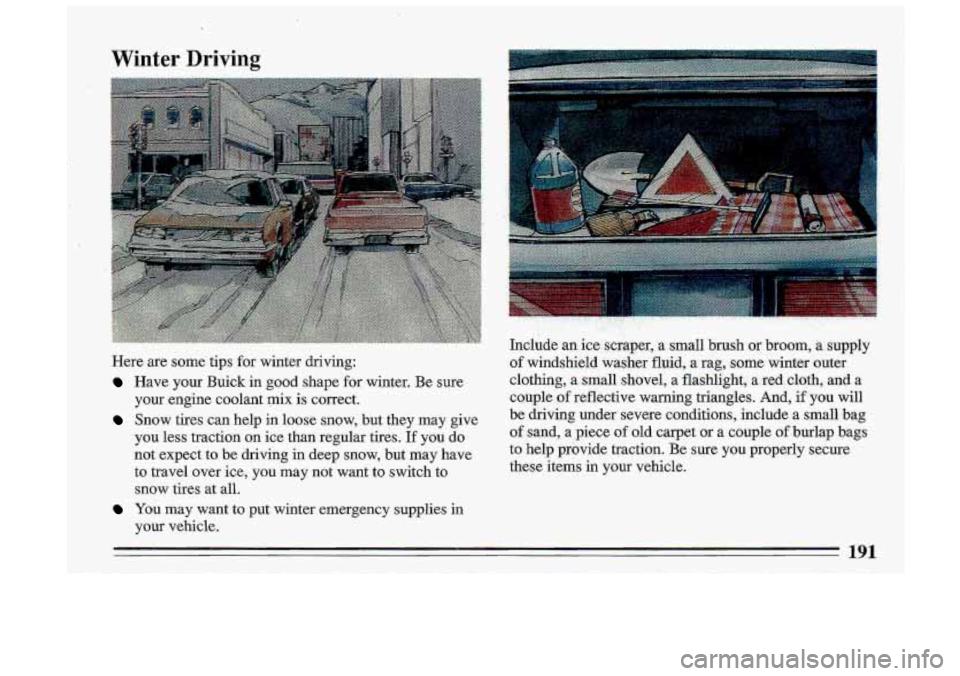
Winter Driving
Here are some tips for winter driving:
Have your Buick in good shape for winter. Be sure
your engine coolant mix is co-rrect.
Snow tires. can help in loose snow, but they may give
you less traction on ice than regular tires. If you do
not expect to be driving
in deep snow, but may have
to travel over ice,
you may not want to switch to
snow tires at all.
You may want to put winter emergency supplies in
your vehicle.
I
I
.. . ..
Include an.ice:scrapGq a small brush .or broom, a supply
of'windshield washer fluid,
a rag, some winter outer
clothing,
a small shovel, a flashlight, a, red. cloth,. and a
couple
.of reflective warning triangles. And, if you will
be driving under:severe conditions, include a small bag
of sand, a piece of ,old carpel .or a couple of burlap. bags
to help provide traction. Be sure y.ou properly secure
these items in your vehicle.
Page 201 of 340
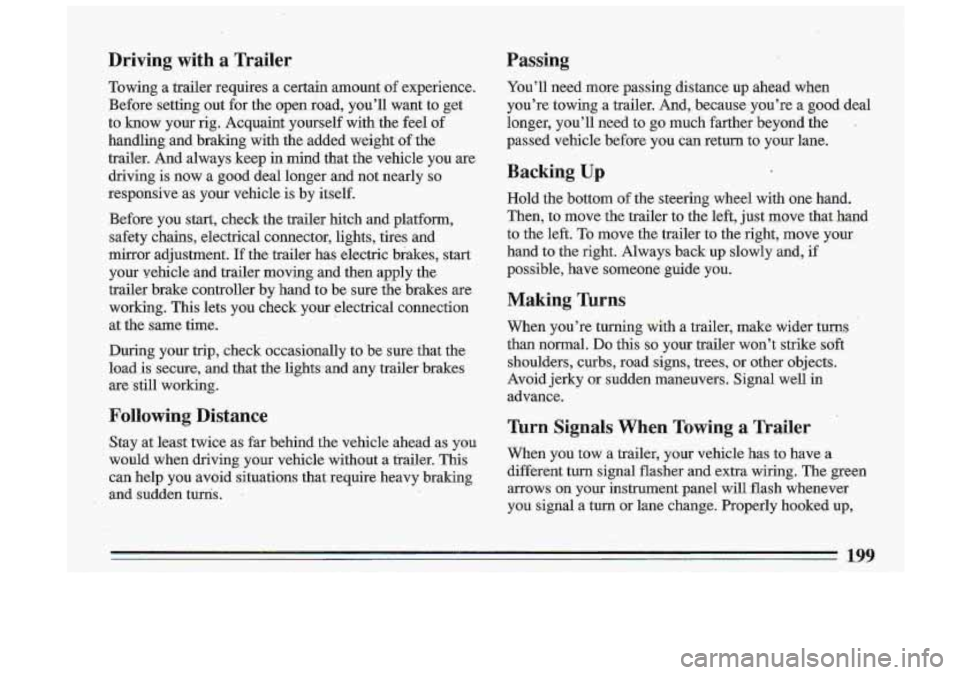
Driving with a Trailer
Towing a trailer requires a certain amount of experience. Before setting out for the open road, you’ll want to get
to
know your rig. Acquaint yourself with the feel of
handling and braking. with the added weight of the
trailer. And always keep in mind that the vehicle you are
driving is now
a good deal longer and not nearly so
responsive as your vehicle is by itself.
Before you start, check the trailer hitch and platform,
safety chains, electrical connector, lights, tires and
mirror adjustment.
If the trailer has electric biakes, start
your yehicle and trailer moving and then apply the
trailer brake controller by hand to be sure the- brakes are
working. This lets you check your electrical connection
at the same time.
During your trip, check occasionally to
be sure that the
load
is secure, and that the Lights.and any trailer brakes
are .still working.
Following Distance
Stay at least twice as far behind the vehicle ahead as you
would when driving your vehicle without a trailer. This
can help
you avoid situations that require heavy braking
and sudden turris.
.
Passing
You’ll need. more passing distance up ahead when
you’re towing a trailer. And, because you’re a good deal \
longer, you’ll need to go much farther beyond the
.
passed vehicle before you can return to your lane.
Backing Up
Hold the bottom of the steering wheel with one hand.
Then, to move the trailer
to the left, just move that hand
to the left.
To mo.ve the trailer to the right, move your
hand to the right. Always back up slowly and, if
possible, have someone guide
you.
Making Turns
When you’re turning with a trailer, make wider turns
than normal.
Do this so your trailer won’t strike soft
shoulders, curbs, road signs, trees, or other objects.
Avoid jerky or sudden maneuvers. Signal well in
advance.
Turn Signals When Towing a Trailer
When you tow a trailer, your vehicle has to have .a
different turn signal flasher and extra wiring. The green
arrows on your instrument panel will
flash whenever
you signal a
turn or lane change. Properly hooked up,
199
Page 248 of 340
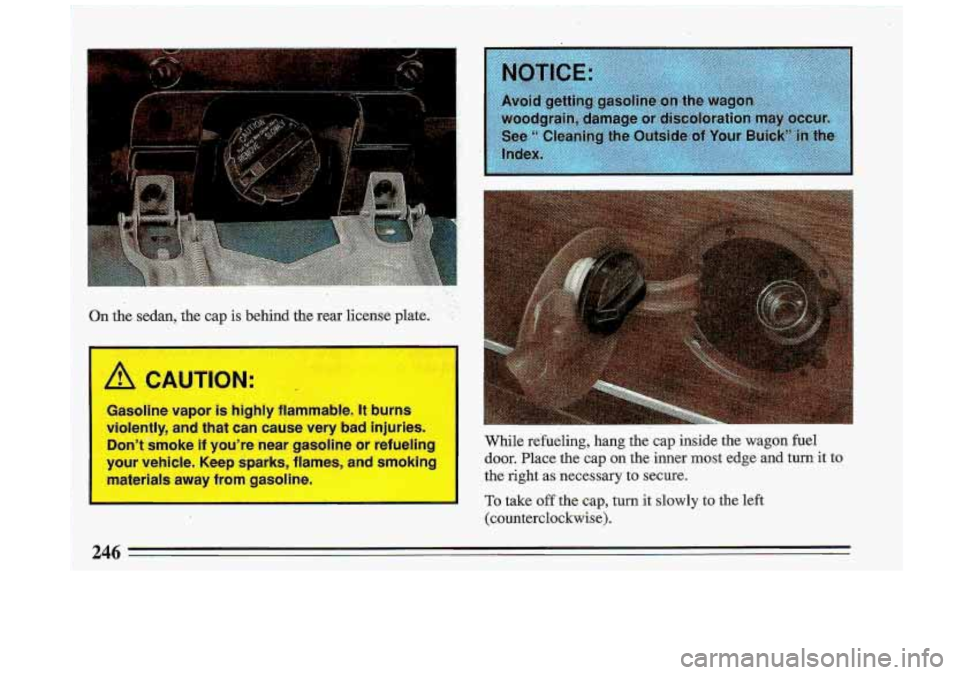
.,
..
On. the sedan, the cap is behind the rear license plate. : '
m--
/! CAUTION:
Ga din rapor is ply tlammawe. It Durn:
violently, and that can cause very
bad injuries.
Don't smoke
if you're near gasoline or refueling
your vehicle. Keep sparks, flames, and smoking
materials away from gasoline. While refueling, hang the cap inside the wagon fuel
door. Place the cap on the inner most edge and turn it to
the
right as. necessary to secure.
To take off the cap, turn it slowly to the left
(counterclockwise).
246 =
Page 272 of 340
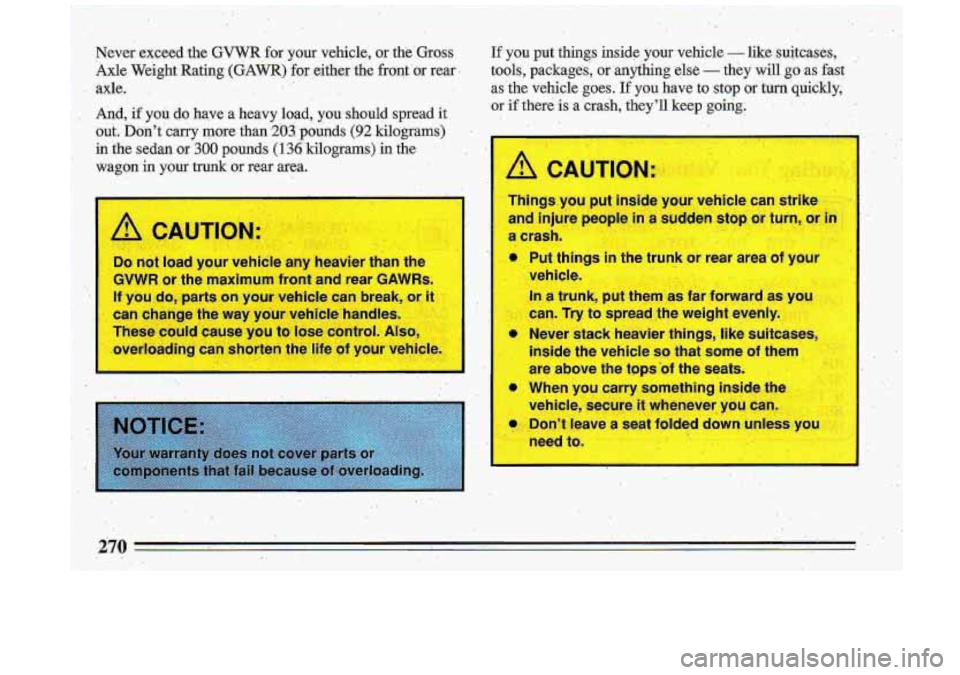
Never exceed the GVWR for.your vehicle, or the"Gross If you put things inside your vehicle - like.suitcases, .,
Axle Weight Rating (GAWR) for ,either the front 'or rear. tools, packages, or anything else - they will go ,as fast '
I -. axle.. as 'the
vehicle goes. If you have to stop or turn quickly,
, And, if you do have a heavy load, you-should spread it
1 . out. Don't 'carry more than.2'03 pounds (92 kilograms)
. wagon in your trunk or rear area. '8
or if.there is a crash, they'll keep goirig. I.
.. .
in the sedan or 300 pounds (136 kilograms-) in the m - .1
: II
A CAUTION:
i I)
Do not load your vehicle any heavier than the
GVWR or the maximum front and rear GAWRs. I
If you do, parts on your vehicle can break, or it
can change the way your vehicle handles.
These could'cause you to lose control.
Also,
.overloadina can shorten the li of vow vehic
(!a CAUTIO1
Things.y Jt inside your vehicle can 'ikt
and injure people in a sudden stop or tuln lr i~
a crash.
the trunk or rear area of your
0 Put things
vehicle.
In a trunk, put.thern'as far forward as vou
can. Try to spread the weight evenly,
* Never stack heavier things, like suitcas,,
inside the vehicle
so that some sf them
are above the tops'of the seats.
When you carry somet,hing inside
thd
vehicle, secure it whenever. you can.
9 Don't lei-? a seat folded down unless yo1
need to.
I